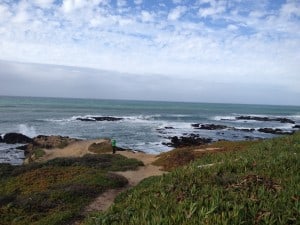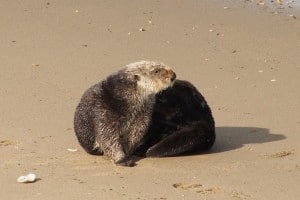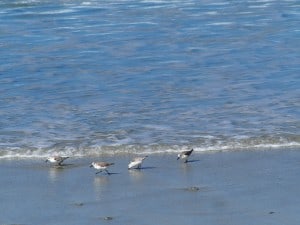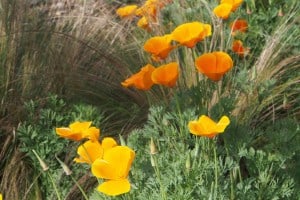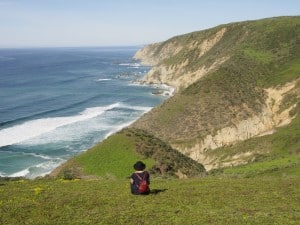For years, my wife and I have wanted to explore California’s legendary Highway 1, which runs along the Pacific coast. It is one of the world’s most scenic drives. Our anticipation was therefore at a peak when we took the storied highway out of San Francisco on a two-day trip down to Monterey and Big Sur. The drive is exactly what we hoped for – only better.
Mile after mile of undeveloped coastline offered up a non-stop parade of beautiful sand dunes, unspoiled beaches and precipitous cliffs. With the added bonus of sunny, warm weather, the drive evoked classic California pop songs like “Ventura Highway”. Not surprisingly, the challenge was keeping our eyes on the road. Red-tailed hawks and turkey vultures soared constantly overhead, while American kestrels, red-shouldered hawks and western meadowlarks perched on roadside fences and telephone wires. Each time we pulled off onto one of the many roadside lookouts, small flocks of Brewer’s blackbirds, California towhees and the ubiquitous white-crowned and golden-crowned sparrows scurried into the grass, only to reappear moments later. Monarch butterflies, too, sailed by, often in pairs. Out over the ocean, there was a steady procession of Brandt’s cormorants, western and California gulls and sea ducks like scoters and mergansers. The first plant to catch my eye was highway iceplant (Carpobrotus edulis), a ground-hugging species with succulent, three-sided leaves and large pink or magenta flowers. Native to coastal South Africa, it forms extensive mats and outcompetes native species for resources.
Moss Landing
As we approached Monterey, we entered a huge area of wetlands known as Elkhorn Slough. We stopped here to explore the Moss Landing Wildlife Area, which was teeming with wildlife. Interpretive signs explained that what were once salt evaporation ponds now provide critical breeding habitat for threatened western snowy plovers. Volunteers actually go out onto the damp mud in early spring to stomp about with their feet to create shallow impressions as nesting sites. Although we didn’t see any of the plovers, we were entertained by hundreds of western sandpipers, willets, whimbrels, black-bellied plovers, greater yellowlegs, and marbled godwits. Brown pelicans and both snowy and great egrets were also easy to spot. The high point, however, was getting leisurely, close-up views of at least a dozen sea otters. Some were floating on their backs, while others were on the beach. Sea otters were once hunted into near oblivion for their pelts. Now, through massive conservation efforts, their numbers are rebounding. Sea otters feast on kelp-eating urchins – baseball-sized, spiny echinoderms. By keeping urchin numbers in check, the otters allow giant kelp “forests” to thrive. This benefits thousands of other species in the marine ecosystem.
I also took some time to walk the trails of the nearby 1400-acre Elkhorn Slough National Estuarine Research Reserve. The huge slough provides a crucial feeding and resting ground for many kinds of migrating waterfowl and shorebirds. One trail wound through stands of coast live oak (Quercus agrifolia), where I enjoyed great views of acorn woodpeckers, chestnut-backed chickadees, spotted towhees and my first ever Hutton’s vireo and Say’s phoebe. Although some of the trees had been clearly affected by the four-year drought, the early winter rains this year had greened the landscape.
Monterey – Big Sur
When we arrived in Monterey, the first thing we did was drive over to Pacific Grove, which is famous for its overwintering monarchs. The butterflies arrive here in November and remain through late February. Although many of the monarchs had already left, we were able to find several dozen clustered on the branches of some of the eucalyptus and Monterey pines. The annual census of 187 coastal California wintering sites showed an increase in monarch numbers this year. However, the population is still 39% below the long-term average. The next morning, I visited the Pacific Grove Museum of Natural History, which provides information on the monarchs as well as great exhibits on nearly all of the state’s flora and fauna. Another highlight of the Monterey area was 17-Mile Drive with its shorebird-dotted beaches – sanderlings were everywhere – and craggy rocks. At Bird Rock, we saw dozens of California sea lions.
After lunch in leafy Carmel-by-the-Sea, a town of fairytale cottages, stately trees and an upscale shopping district, we continued southward towards Big Sur. Although Highway 1 had already delivered spectacular scenery, the drive from Carmel to Big Sur was even more jaw-dropping with its cypress and redwood forests, bucolic meadows, colossal cliffs, crashing waves and elegant bridges. I kept an eye on the sky, too, hoping to see a California condor. With a wingspan of nearly ten feet, the condor is North America’s largest bird. The species nearly went extinct in the 1980s, when the population crashed to only nine wild birds. A captive breeding program was started in which the young were hand-reared to maximize reproduction. The young were released into parts of Arizona and California, including Big Sur. There are now over 400 California condors, including about 230 in the wild.
Port Reyes
The final leg of our trip took us to Point Reyes National Seashore, a 71,000-acre park preserve located on a peninsula just north of San Francisco. Its rocky headlands, expansive sand beaches, bird-rich estuaries, open grasslands, scrubby chaparral, and upland pine forests make the park a naturalist’s and photographer’s delight. Nearly half of all North American bird species either nest, winter or migrate through here. In spring, the grasslands come alive in a spectacular floral explosion.
After we got settled in the charming cottage we rented at the edge of the park, we made the half-hour drive to the lighthouse. Raptors were everywhere as we wound our way through sweeping grasslands and green pastures, where some dairy farming is still permitted. From the lighthouse, we looked down on barnacle-encrusted rocks covered with hundreds of common murres, a penguin-like seabird. We also scanned the ocean for the tell-tale “spouts” of gray whales, which were already migrating north. These whales make one of the longest of all mammalian migrations – a 12,000 km round trip between breeding and calving grounds in the lagoons of Baja California to summer feeding territories in the Bering and Chukchi Seas.
After the lighthouse, we made our way to the Chimney Rock Trail, where rocky cliffs drop steeply to the ocean. The trumpeting of elephant seals – the sound can carry for over a kilometre – emanated from the beach below. We watched in amazement as a pair of large males fought for access to females. The latter had only just finished weaning their pups!
Over the next two days, we managed to hike three of the park’s numerous trails. Abbott’s Lagoon Trail took us through coastal chaparral to a lagoon, sand dunes, beach and huge mudflats. The shrubs were alive with sparrows and even a few brush rabbits. I was hoping to see a bobcat, which are fairly common in the park and even seen during the day. Our most interesting find, however, was a covey of California quails. One of the males, with its a striking, black and white facial pattern and long, curved head plume, sat perched atop a trailside shrub, resplendent in the early morning sunshine. Here and there, orange-yellow California poppies, the state flower, were already blooming.
The Tomales Point Trail took us over high hills with magnificent views of the ocean and the 19 km Tomales Bay. The San Andreas Fault lies directly beneath the bay. It forms the tectonic boundary between the Pacific Plate and the North American Plate. Point Reyes sits on the Pacific Plate, while the rest of California is on the North American Plate. In the 1906 earthquake, the peninsula leapt nearly 20 feet northward in less than a minute! All of this is explained in detail on the Earthquake Trail near the main visitor centre. You can even see a fence that broke in two during the quake. One section now sits almost 20 feet north of the other. The Tomales Point area is also home to the Tule elk, a rare sub-species of the American elk. We watched a herd of 60 animals as they grazed on a hillside. To top off the hike, a pair of exquisite western bluebirds posed for us on the roof of an old barn.
Before leaving Point Reyes, we walked along the Estero Trail, where bat rays and sharks are often seen. Shorebirds and ducks were abundant on the mudflats of the estuary. The trail took us through some large stands of rare Bishop’s pines, draped in lichens. Pink flowering currants were in full bloom and smelled wonderful. A little pishing on my part was sufficient to coax several pygmy nuthatches into view as well as a Bewick’s wren.
If you want to visit California, I suggest you don’t wait too long. Climate change is having a profound impact on water resources, as evidenced by changes in snowpack and river flows. The on-going drought has killed millions of trees, and the warmer waters are wreaking havoc on native fish like salmon. Unprecedented warm waters off the Pacific coast over the past two years have led fish that marine mammals feed on to move to colder waters. This has resulted in record numbers of sick and starving sea lions. Increased global temperatures also threaten the cool, moist coastal zone of the state, which could mean the end of coast redwoods. These impacts should serve as another reminder – as if we need one – of the need for aggressive mitigation policies such as carbon taxes.
